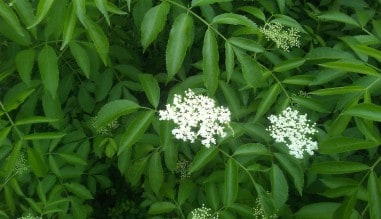
It is an interesting paradox that teeth are the hardest part of the human body and often seem to succumb first to dietary and lifestyle imbalances. Of course, this is for some obvious reasons: like  that they are exposed (where bones are hidden within the body) and that it is their hard design in which the dentin and enamel is so saturated with calcium and other minerals rather than the regenerative tissue of the rest of the body. Since the teeth are so easily eroded by sugar and lack of care, it is certainly important to emphasize prevention.
that they are exposed (where bones are hidden within the body) and that it is their hard design in which the dentin and enamel is so saturated with calcium and other minerals rather than the regenerative tissue of the rest of the body. Since the teeth are so easily eroded by sugar and lack of care, it is certainly important to emphasize prevention.
By Nathaniel Whitmore a Contributing Author to SHTFBlog and SurvivalCache
Follow up article to: 5 Emergency Toothache Remedies From Wild Plants
Keep the teeth clean! In the absence of modern dental care supplies like toothbrushes and toothpaste (this is not the place to get into the subject of fluoride, but do your research), you should use fresh sticks from non-poisonous trees. (Get to know your trees!) I recommend Birch (Black or Yellow, Betula lenta and B. alleghaniensis), Sassafras (Sassafras albidum), or Spicebush (Lindera benzoin) for their pleasant tastes and antimicrobial properties. Of course there is also, though not some common in my area, the Toothache Tree, or Prickly Ash, (Zanthoxylum).
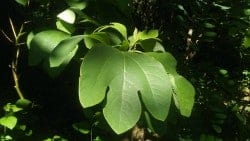
Sassafras makes a tasty toothpick!
When prevention fails, you can consider these five natural remedies. Before you scoff at the possible benefits of natural remedies for toothaches, please allow me to mention that I do have a bit of first-hand experience with the subject, both in treating my own toothache and in helping others. Certainly, it is noteworthy that tooth problems can be very dangerous and one who suffers should seek appropriate care. The following remedies are offered for consideration as adjunct treatment, when in the wilderness, and otherwise to empower people to take care of themselves and to be prepared for any problem in any situation, including when far away from professional dental care.
- We have already begun discussing a group of important remedies for teeth- medicinal trees. In addition to Birch, Sassafrass, and Prickly Ash, we also have remedies from the evergreens like Pine (see: https://survivalcache.com/five-emergency-toothache-remedies-from-wild-plants/) and many others, like Willow (Salix). The benefits of these generally include antimicrobial and pain-relieving properties, as well as their form, with twigs being easily whittled into toothpicks. The pitch of evergreens can also aid in application, such as in filling a cavity with pitch. In other parts of the world Frankincense (Boswellia) and Myrrh (Commiohora) are used in this way. Native Americans used Hemlock (Tsuga), Oak (Quercus), and Black Walnut (Juglans nigra) in addition to those already mentioned.
- Moxibustion is a therapy that is utilized alongside acupuncture and shiatsu (see: https://survivalcache.com/five-best-diy-toothache-remedies-do-it-yourself-homemade/ which includes a section on shiatsu). It consists of burning moxa, or dried Mugwort (Artemisia) on acupoints. There are both distal points located on the meridians (energy channels) sometimes in other areas besides the location of pain, and local points that are in the area of the pain.
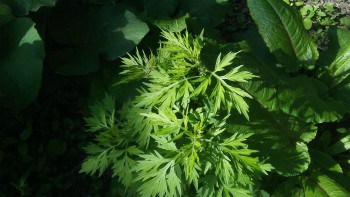
Mugwort (Artemisia vulgaris). Several Artemisia species are used to make moxa, a dried Mugwort leaf fluff that is burned in moxibustion therapy. Many Artemisia species are used as herbal remedies to treat toothache and many other ailments, generally in the form of infusion (“tea”) or poultice.
Pain is a vicious cycle in that it produces tension that decreases the movement of energy and blood and therefore contributes to the discomfort and inhibits the healing process. So, the reaction to pain often adds to it! Moxibustion, shiatsu, and acupuncture can be very effective for treating the pressure points involved in toothache. There are two types of moxibustion. Indirect moxa includes using a moxa roll, which is like a cigarette or cigar of moxa. The moxa roll is lit to produce a nice ember that is held close to the acupoints in order to treat them with heat. In direct moxa the moxa is place on the skin, lit with incense or a hot stick from the fire, and then snuffed out. Moxibustion has been revered since ancient times for the treatment of many illnesses and problems. At various times it has been used alongside acupuncture. But, this is fading in modern times because we are less accustomed to the smoke and because it can be a time-consuming therapy. For pain, though, it can be very effective.
It is also interesting that Native Americans utilized moxa-type therapies, such as the treatment of acupoints with the glowing embers on sticks from the fire. Western tribes, at least, also utilized Artemisia species besides as toothache remedies.
- Another toothache remedy from the fireplace is charcoal. I first learned of charcoal for teeth through George Ohsawa’s books on macrobiotics which discuss Japanese healing and disease prevention methods. A preparation known as dentie is prepared with the charcoal of Eggplant or Eggplant tops (including stems, like the part sliced off when preparing Eggplant as food) and sea salt. The resulting powder when these two ingredients are combined can be used to brush one’s teeth or can be applied to the area of toothache. Charcoal is mildly abrasive and effective for cleaning the teeth. It is also very absorbent and helps remove microbial and toxic buildup from the mouth.
Recently, I saw a dental product being advertised that utilized the charcoal of Coconut. Presumably, you could prepare a survival remedy in the wild with use of wood charcoal from the fireplace. Although charcoal is largely reduced to carbon and has much of the source material’s properties removed, I assume it would be wise to know the source of materials before preparing remedies from charcoal. I wouldn’t want to use charcoal from poisonous or contaminated sources. Hopefully, though, if you are in a survival situation you are not huddling over and cooking with a fire of poisonous or contaminated wood.
- The subject of dentie brings us to another simple toothache remedy, salt. Salt can be used to brush the teeth and as a gargle. To prepare salt water simply dissolve salt in hot water. Let the water cool a bit after adding salt and mixing to avoid burning the mouth, but it is best to use the mouthwash while the water is still warm. Gargling with and swishing salt in the mouth can help remove infection from the mouth while also stimulating the lymph.
- Herbs. See Five Best DIY Toothache Remedies where I discuss Barberry (Berberis) and Toothache Plant (Acmella or Spilanthes) and Five Emergency Toothache Remedies From Wild Plants where I discuss additional berberine-containing herbs, Echinacea, Prickly Ash, Calamus, and Spruce.
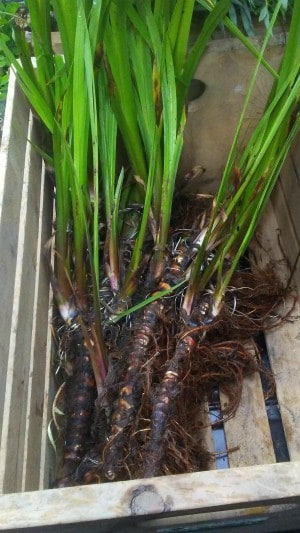
Calamus is a Native American toothache remedy.
We should take a moment to discuss the word “herb”. Botanically “herb” refers to the herbaceous, or non-woody growth of a plant. Woody plants are those with stems that persist. Trees, shrubs, and vines have woody, perennial growth. While herbaceous plants are those without perennial woody portions, though they may have perennial roots (such as Pokeweed, which sends up fresh stalks year after year from a large root, and Japanese Knotweed, which does the same). Usually in medical herbology when the part of the plant used is defined as the “herb” (sometimes “aerial portions”) it refers to the leaves, flowers, and herbaceous stems. Generally, though, “herb” in the sense of a “medicinal herb” refers to leaves, roots, rhizomes, flowers, seeds, stems, and other parts used as herbal medicine. In many herbal traditions, insects, minerals, and animals parts are also loosely considered “herbs” (as in medicinal substances) and included in “herbal formulas”. The first toothache category I mentioned above, the trees, is separated from this group simply based on the trees being able to provide us with toothpick and toothbrushes (or, more properly, brushing sticks), and because it is interesting to consider all that trees, as a group, provide us for dental care.
Here, regarding herbal toothache remedies, we are including herbs, roots, and other plant parts. Especially roots are employed for toothaches because of their substantial form, which can contain much medicinal substance and which can easily be held in the mouth or packed into a dental cavity. Probably much of the reason Calamus (Acorus) was favored by Natives as a toothache remedy is because of the form of the rhizome could be easily cut to various sizes for application. This is, of course, besides its medicinal virtues, which include a strong aromatic property. Just as in Chinese medicine, Native remedies for pain are often aromatic herbs. (Calamus was revered in many herbal traditions, including Native, Chinese, Ayurvedic, and European.)
Osha, or Bear Root (Ligusticum porteri) is one of my favorite herbs for toothaches and other infections, including throat. I hesitate to mention it because of its increasing popularity and limited availability from wild sources. But, hopefully cultivated sources will become more available for public use. Definitely, those living the the Rocky Mountains should know about Bear Root for emergency use, as it is a remarkable herb.
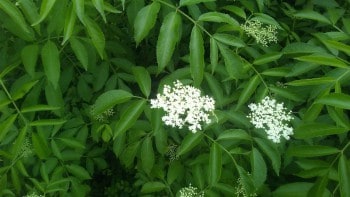
Elder is a Native American remedy for toothache.
Licorice (Glycyrrhiza) is a tasty root (though not to all) that can be readily obtained through Chinese and American herb stores and is increasingly being cultivated in this country. It can be purchased in a whole form, rather than sliced or ground, that works for a brushing stick. The sliced form also works nicely for tucking into the cheek.
With these roots and herbs, including Toothache Plant, Echinacea, and others mentioned above and in the linked articles, it is best to chew them in order to keep the herb local (near the toothache). Taken internally as beverages, tinctures, or capsules, the herbs will have to be taken in through the digestive system, filtered with the blood, and circulated through the blood vessels before arriving at the afflicted area. Best is to tuck the herb into your gum near the toothache and keep it there, chewing on occasion to release the medicinal virtues and otherwise letting the herb juice soak into the gums. Dispose of the herbs when they seem used up or just to give your mouth a break and then repeat later. The duration and repetition will have to be felt out, allowing some lag-time for the effects to sink in, because of the variability regarding herb choice and severity of the toothache.
Visit Amazon Sponsors of SurvivalCache.com
The post Five More Natural Toothache Remedies appeared first on Survival Cache.
from Survival Cache https://survivalcache.com/five-more-natural-toothache-remedies/

No comments:
Post a Comment